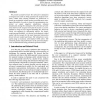Free Online Productivity Tools
i2Speak
i2Symbol
i2OCR
iTex2Img
iWeb2Print
iWeb2Shot
i2Type
iPdf2Split
iPdf2Merge
i2Bopomofo
i2Arabic
i2Style
i2Image
i2PDF
iLatex2Rtf
Sci2ools
97
Voted
PG
2000
IEEE
2000
IEEE
Interactive Simulation of Surgical Cuts
We present a framework for the interactive simulation of surgical cuts such as being practiced in surgical treatment. Unlike most existing methods our framework is based on tetrahedral volume meshes providing more topological flexibility. In order to keep the representation consistent we apply adaptive subdivision schemes dynamically during the simulation. The detection of collisions between the surgical tool and the tissue is accomplished by using an axis aligned bounding box hierarchy which was adapted for deformable objects. For haptic rendering and feedback, we devised a mechanical scalpel model which accounts for the most important interaction forces between scalpel and tissue. The relaxation is computed using a localized, semi-implicit ODE solver. The achieved quality and performance of the presented framework is demonstrated using a human soft tissue model.
Related Content
| Added | 01 Aug 2010 |
| Updated | 01 Aug 2010 |
| Type | Conference |
| Year | 2000 |
| Where | PG |
| Authors | Daniel Bielser, Markus H. Gross |
Comments (0)

